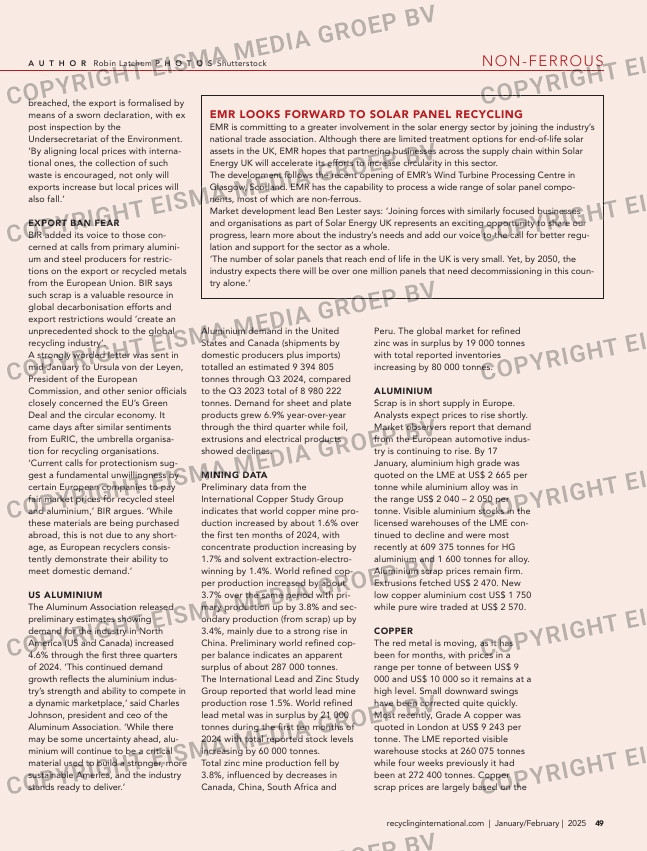Page 49 from: Recycling International Jan/Feb 2025

NON-FERROUS
Few signs of growth
breached, the export is formalised by
means of a sworn declaration, with ex
post inspection by the
Undersecretariat of the Environment.
‘By aligning local prices with interna-
tional ones, the collection of such
waste is encouraged, not only will
exports increase but local prices will
also fall.’
EXPORT BAN FEAR
BIR added its voice to those con-
cerned at calls from primary alumini-
um and steel producers for restric-
tions on the export or recycled metals
from the European Union. BIR says
such scrap is a valuable resource in
global decarbonisation efforts and
export restrictions would ‘create an
unprecedented shock to the global
recycling industry’.
A strongly worded letter was sent in
mid-January to Ursula von der Leyen,
President of the European
Commission, and other senior officials
closely concerned the EU’s Green
Deal and the circular economy. It
came days after similar sentiments
from EuRIC, the umbrella organisa-
tion for recycling organisations.
‘Current calls for protectionism sug-
gest a fundamental unwillingness by
certain European companies to pay
fair market prices for recycled steel
and aluminium,’ BIR argues. ‘While
these materials are being purchased
abroad, this is not due to any short-
age, as European recyclers consis-
tently demonstrate their ability to
meet domestic demand.’
US ALUMINIUM
The Aluminum Association released
preliminary estimates showing
demand for the industry in North
America (US and Canada) increased
4.6% through the first three quarters
of 2024. ‘This continued demand
growth reflects the aluminium indus-
try’s strength and ability to compete in
a dynamic marketplace,’ said Charles
Johnson, president and ceo of the
Aluminum Association. ‘While there
may be some uncertainty ahead, alu-
minium will continue to be a critical
material used to build a stronger, more
sustainable America, and the industry
stands ready to deliver.’
49recyclinginternational.com | January/February | 2025
A U T H O R Robin Latchem P H O T O S Shutterstock
EMR LOOKS FORWARD TO SOLAR PANEL RECYCLING
EMR is committing to a greater involvement in the solar energy sector by joining the industry’s
national trade association. Although there are limited treatment options for end-of-life solar
assets in the UK, EMR hopes that partnering businesses across the supply chain within Solar
Energy UK will accelerate its efforts to increase circularity in this sector.
The development follows the recent opening of EMR’s Wind Turbine Processing Centre in
Glasgow, Scotland. EMR has the capability to process a wide range of solar panel compo-
nents, most of which are non-ferrous.
Market development lead Ben Lester says: ‘Joining forces with similarly focused businesses
and organisations as part of Solar Energy UK represents an exciting opportunity to share our
progress, learn more about the industry’s needs and add our voice to the call for better regu-
lation and support for the sector as a whole.
‘The number of solar panels that reach end of life in the UK is very small. Yet, by 2050, the
industry expects there will be over one million panels that need decommissioning in this coun-
try alone.’
Aluminium demand in the United
States and Canada (shipments by
domestic producers plus imports)
totalled an estimated 9 394 805
tonnes through Q3 2024, compared
to the Q3 2023 total of 8 980 222
tonnes. Demand for sheet and plate
products grew 6.9% year-over-year
through the third quarter while foil,
extrusions and electrical products
showed declines.
MINING DATA
Preliminary data from the
International Copper Study Group
indicates that world copper mine pro-
duction increased by about 1.6% over
the first ten months of 2024, with
concentrate production increasing by
1.7% and solvent extraction-electro-
winning by 1.4%. World refined cop-
per production increased by about
3.7% over the same period with pri-
mary production up by 3.8% and sec-
ondary production (from scrap) up by
3.4%, mainly due to a strong rise in
China. Preliminary world refined cop-
per balance indicates an apparent
surplus of about 287 000 tonnes.
The International Lead and Zinc Study
Group reported that world lead mine
production rose 1.5%. World refined
lead metal was in surplus by 21 000
tonnes during the first ten months of
2024 with total reported stock levels
increasing by 60 000 tonnes.
Total zinc mine production fell by
3.8%, influenced by decreases in
Canada, China, South Africa and
Peru. The global market for refined
zinc was in surplus by 19 000 tonnes
with total reported inventories
increasing by 80 000 tonnes.
ALUMINIUM
Scrap is in short supply in Europe.
Analysts expect prices to rise shortly.
Market observers report that demand
from the European automotive indus-
try is continuing to rise. By 17
January, aluminium high grade was
quoted on the LME at US$ 2 665 per
tonne while aluminium alloy was in
the range US$ 2 040 – 2 050 per
tonne. Visible aluminium stocks in the
licensed warehouses of the LME con-
tinued to decline and were most
recently at 609 375 tonnes for HG
aluminium and 1 600 tonnes for alloy.
Aluminium scrap prices remain firm.
Extrusions fetched US$ 2 470. New
low copper aluminium cost US$ 1 750
while pure wire traded at US$ 2 570.
COPPER
The red metal is moving, as it has
been for months, with prices in a
range per tonne of between US$ 9
000 and US$ 10 000 so it remains at a
high level. Small downward swings
have been corrected quite quickly.
Most recently, Grade A copper was
quoted in London at US$ 9 243 per
tonne. The LME reported visible
warehouse stocks at 260 075 tonnes
while four weeks previously it had
been at 272 400 tonnes. Copper
scrap prices are largely based on the
48-49-50_manon-ferrous.indd 49 29-01-2025 11:32



